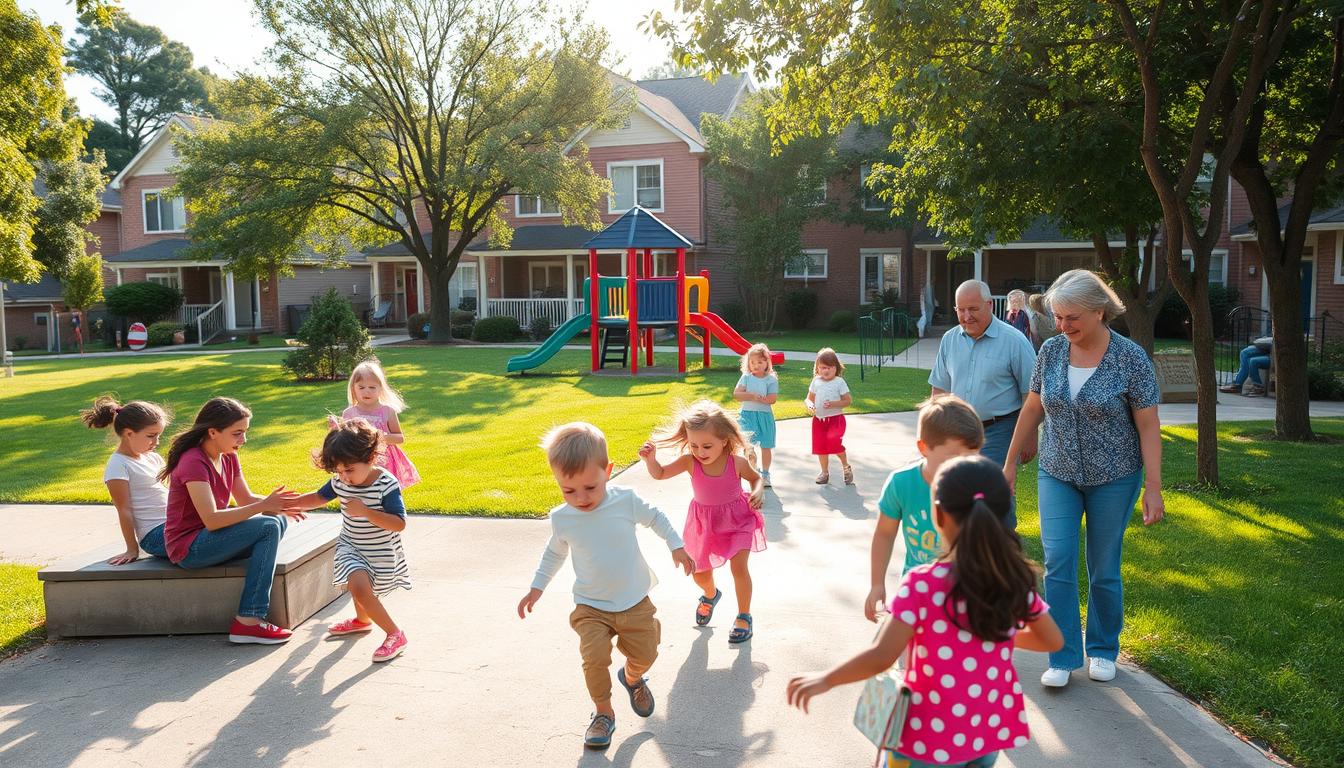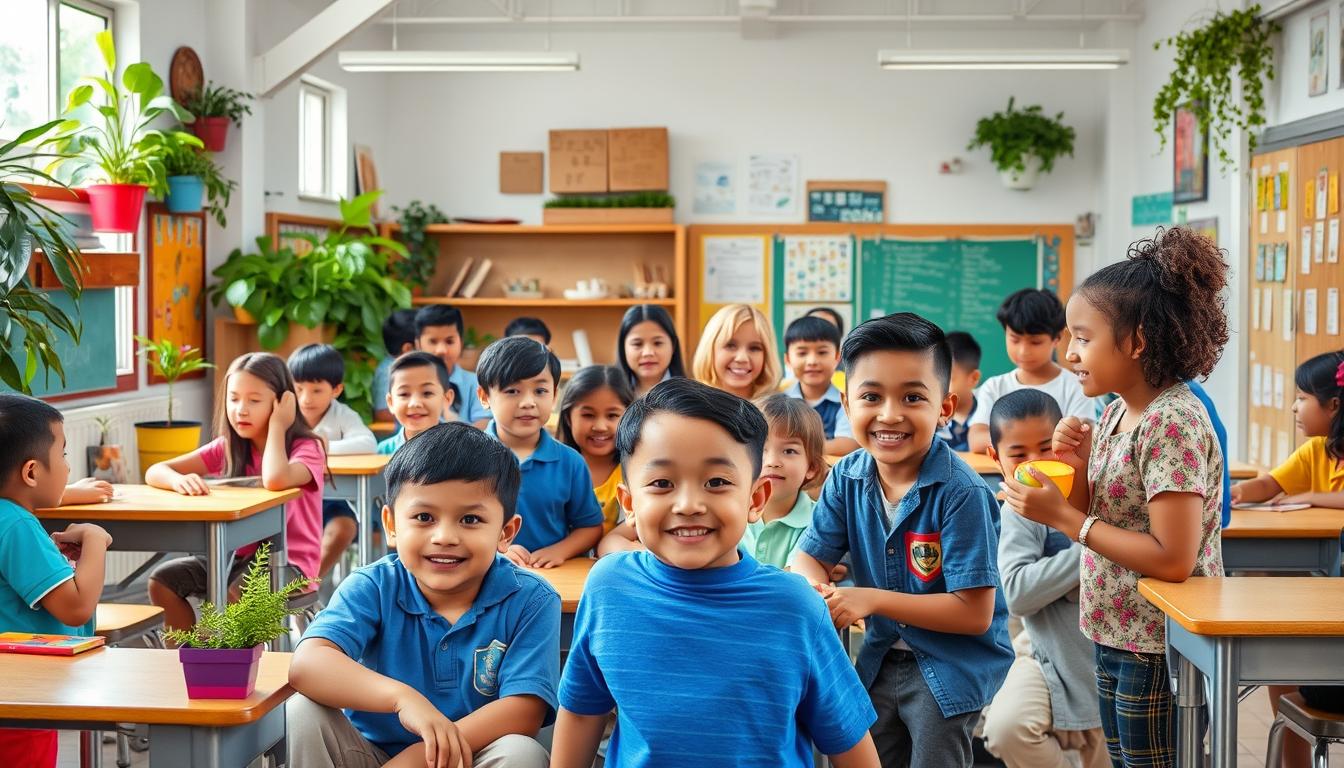Growing up in a safe neighborhood greatly affects a child’s mind and social skills. My research shows how important our surroundings are for a child’s growth and happiness.
Neighborhood safety does more than just keep kids safe. It shapes how they feel and act. Safe places help kids feel free to explore and learn without fear.
Our cities tell stories of strength, chance, and dreams. Learning about the impact of safety on kids helps us build better places. These places can help young minds grow and reach their dreams.
Key Takeaways
- Safe neighborhoods contribute significantly to positive child development
- Environmental factors directly influence psychological growth
- Community infrastructure plays a critical role in child well-being
- Children’s emotional security is closely linked to neighborhood safety
- Early environment shapes long-term behavioral patterns
Understanding the Link Between Safe Neighborhoods and Child Development
Neighborhoods are key in shaping a child’s mind and growth. The environment around kids affects their mental and social life. This creates a complex world of learning and interaction.
Children are very sensitive to their surroundings. The safety and order of a neighborhood greatly shape their development. It’s vital to understand how community environments and child well-being are connected.
Defining Neighborhood Safety Metrics
Measuring neighborhood safety is more than just looking at crime rates. Researchers look at several important factors:
- Physical infrastructure quality
- Community engagement levels
- Social support networks
- Accessibility of public spaces
Key Environmental Factors in Child Development
Socioeconomic factors greatly affect a child’s development. Important environmental factors include:
- Available recreational spaces
- Quality of local educational resources
- Presence of supportive community programs
- Sense of collective neighborhood safety
“A child’s environment is their first classroom, teaching them about safety, interaction, and possible.” – Child Development Research Institute
The Role of Community Infrastructure
Well-designed community spaces are vital for development. Parks, community centers, and safe paths help kids grow physically and mentally. They offer chances for exploration, socializing, and learning.
My research shows that strong infrastructure in neighborhoods helps kids develop important life skills. They learn through supervised yet independent experiences.
The Effects of Neighborhood Safety on Child Development
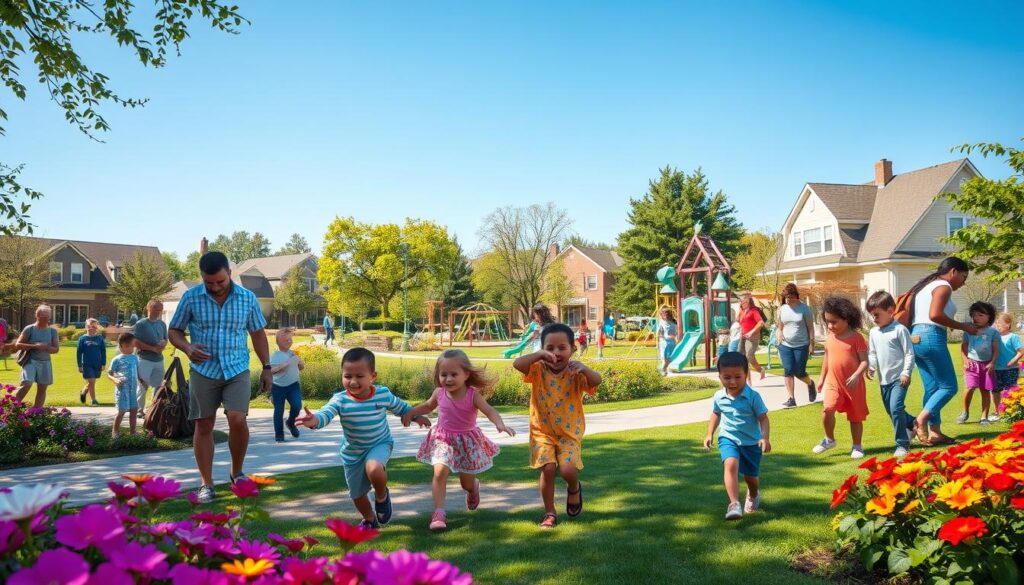
Neighborhood safety is key for a child’s mind and body growth. My studies show kids in safe places grow differently than those in danger zones.
Experts say safety goes beyond just physical space. Safe areas give kids the chance to grow in many ways:
- Less stress
- Better social skills
- More playtime outside
- Improved mood control
How a child thinks and learns is shaped by their surroundings. In safe spots, kids can:
- Play freely
- Meet new people
- Feel brave exploring alone
“A child’s future is linked to their feeling safe and secure” – Dr. Rebecca Martinez, Child Development Researcher
Brain studies show that constant danger can cause lasting stress. This can harm a child’s brain and emotional growth.
By making neighborhoods safer, we help our children grow up strong and healthy.
Impact of Crime Rates on Children’s Psychological Well-being
Living in areas with high crime rates can deeply affect a child’s mind. The danger around them shapes their view of the world. It creates emotional and mental hurdles.
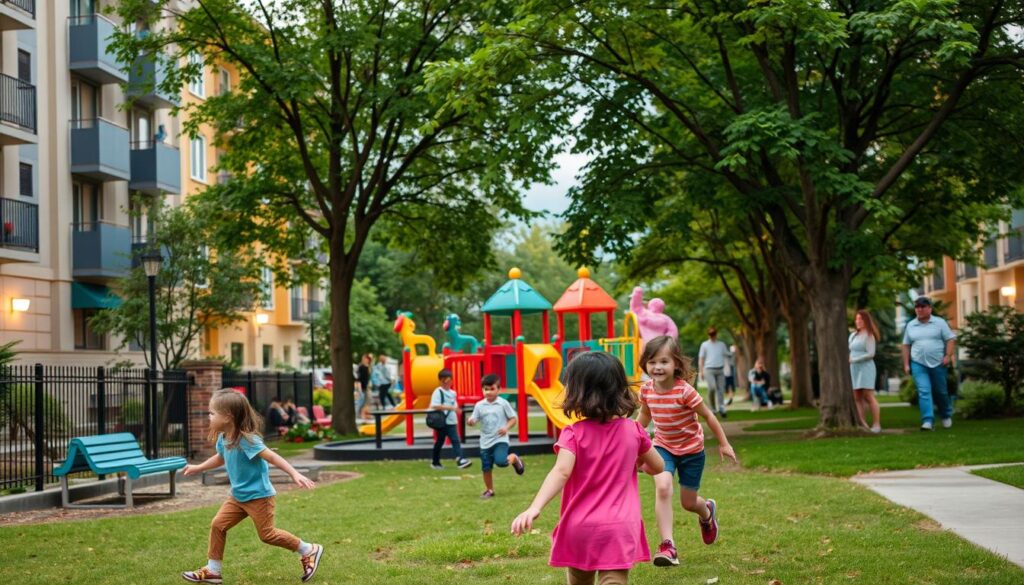
It’s important to understand how crime affects kids’ minds. Studies show that kids in unsafe areas face mental health issues. These problems are not just short-term stress.
Stress and Anxiety in High-Crime Areas
Kids in crime-prone areas often feel more anxious and stressed. These feelings can show up in many ways. For example:
- Hypervigilance and constant alertness
- Difficulty sleeping or experiencing nightmares
- Increased emotional sensitivity
- Rapid physiological stress reactions
Behavioral Changes and Coping Mechanisms
Experts say kids find ways to cope with danger. They might:
- Withdraw emotionally
- Show more protective instincts
- Become more aware of their surroundings
- Use aggressive behavior to defend themselves
Long-term Mental Health Implications
The effects of crime on kids’ minds can last a lifetime. Being in unsafe places for too long can lead to serious mental health issues. These include:
- Post-traumatic stress disorder
- Depression
- Anxiety disorders
- Difficulty managing emotions
“Children are resilient, but continuous exposure to unsafe environments can fundamentally reshape their psychological landscape.” – Dr. Emily Rodriguez, Child Psychology Researcher
It’s key to understand these mental effects. This knowledge helps create support for kids in dangerous areas. It’s about helping them deal with and get past the challenges of living in high-crime neighborhoods.
Physical Activity and Outdoor Play in Safe vs. Unsafe Neighborhoods
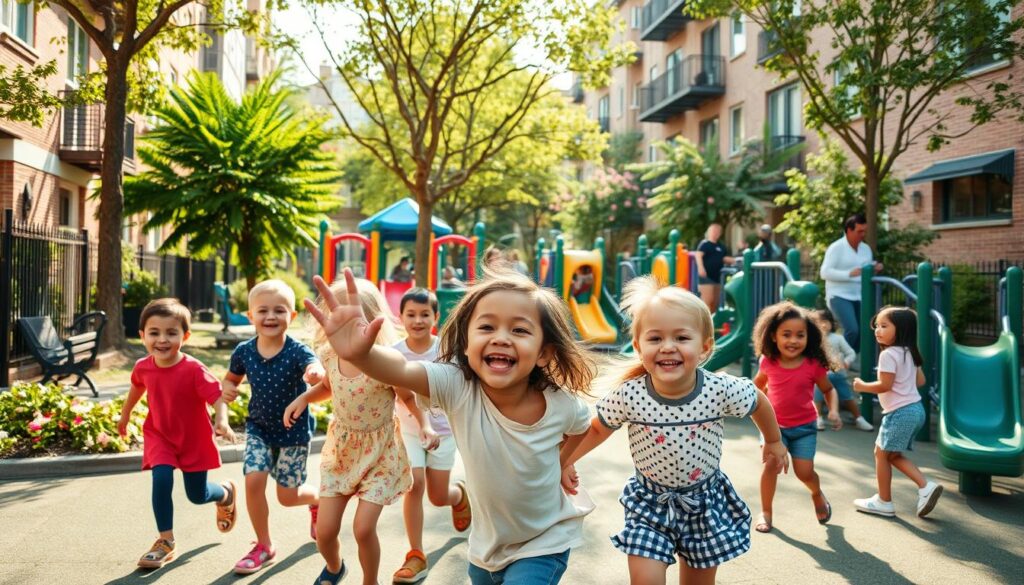
Neighborhood safety is key for kids’ physical activity and growth. Urban planning shapes how kids play outside. In safe areas, kids get more chances to play, make friends, and stay healthy.
Outdoor experiences are shaped by the environment. Safe public spaces help kids explore, move, and learn social skills. Studies show kids in safe spots play more outside. This is good for their motor skills and health.
“A child’s ability to play freely outdoors is a key indicator of neighborhood safety and community well-being.” – Urban Development Research Institute
- Safe neighborhoods have special play areas
- Parks and recreation spaces help with physical activity
- Low-crime areas let kids explore on their own
- Community design affects how kids move
Urban planning can change tough areas. By making green spaces safe, adding safety features, and designing for kids, cities help kids grow.
Safe outdoor spaces are an investment in kids’ health. With smart urban design, we can make places where kids are active, social, and happy.
Socioeconomic Factors and Their Influence on Neighborhood Safety
Neighborhood safety is closely linked to socioeconomic factors. These factors shape urban areas and public health. They affect children’s growth and development.
Looking into urban planning shows us how socioeconomic factors lead to safety gaps. This is important to understand.
Income Disparities and Access to Safe Spaces
Low-income areas face big challenges in keeping communities safe. These issues include:
- Reduced infrastructure maintenance
- Limited recreational spaces
- Higher crime rates
- Inadequate public services
Educational Opportunities and Community Resources
Good education is key to improving neighborhoods. Schools are vital for community stability. They offer:
- Safe learning environments
- Structured after-school programs
- Community engagement opportunities
- Skill development pathways
Public Investment in Safety Measures
Public investments can greatly change neighborhoods. Funding for infrastructure, community centers, and youth programs builds safety networks.
“Investment in community resources is an investment in our children’s future.” – Urban Development Expert
By tackling socioeconomic gaps through urban planning, we can improve safety and child development. This is a holistic approach.
Creating Safe Environments Through Community Action
Improving neighborhood safety needs teamwork from everyone. This includes residents, local groups, and government. Urban planning is key in making places safe for kids and good for the community.
“Strong communities create safe spaces for children to grow and thrive.” – Urban Safety Research Institute
Good community plans can really make a difference. Here are some ways to help:
- Start neighborhood watch programs
- Build community centers for kids
- Work together on parenting tips
- Redesign public spaces
Parents play a big role in making areas safer. They can help by:
- Hosting community meetings
- Supporting programs for kids
- Working with schools on safety
| Community Action Strategy | Impact Level | Implementation Difficulty |
|---|---|---|
| Neighborhood Watch | High | Low |
| Community Center Programs | Medium | Medium |
| Urban Design Improvements | High | High |
Urban planning experts say safety needs constant community effort and action.
Conclusion
The impact of neighborhood safety on kids is huge. Urban planning and public health are key in making safe places for kids. Every child needs a safe area to grow, learn, and play without fear.
Improving neighborhood safety needs teamwork from leaders, policymakers, and locals. Investing in better infrastructure and community programs can make a big difference. This way, kids can grow strong, make friends, and feel good about themselves.
Understanding how environment affects kids is vital. We must keep working to make neighborhoods safe. It’s not just about stopping crime. It’s about creating a place where kids can grow and thrive.
Creating safer neighborhoods is a long-term effort. We need to keep studying and working together. My goal is to encourage everyone to help make safe spaces for kids to reach their dreams.

